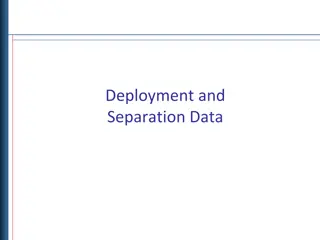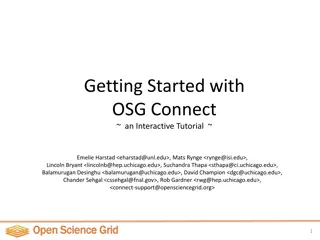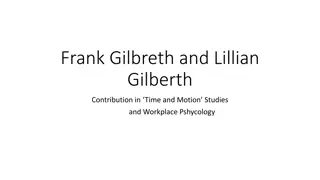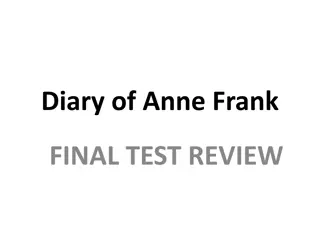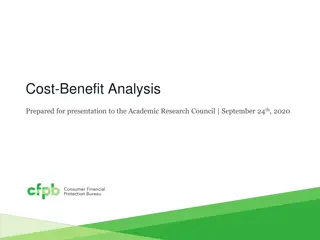OSG.OSDF Deployment & Use by Frank W. Rthwein July 8th, 2024
The OSG.OSDF deployment and usage by Frank W. Rthwein, Executive Director at UCSD/SDSC on July 8th, 2024, showcases the significant contributions from 35 institutions to the OSDF today. The cache system efficiently handles data access, with insights on network traffic savings and historical growth patterns. Dive into real-time visualizations and fun facts for June 2024, including user statistics, file transfers, and top data users in OSPool. Explore the diverse scientific projects and data utilization across various institutions, highlighting the impact and utilization of OSDF in cutting-edge research.
Download Presentation

Please find below an Image/Link to download the presentation.
The content on the website is provided AS IS for your information and personal use only. It may not be sold, licensed, or shared on other websites without obtaining consent from the author.If you encounter any issues during the download, it is possible that the publisher has removed the file from their server.
You are allowed to download the files provided on this website for personal or commercial use, subject to the condition that they are used lawfully. All files are the property of their respective owners.
The content on the website is provided AS IS for your information and personal use only. It may not be sold, licensed, or shared on other websites without obtaining consent from the author.
E N D
Presentation Transcript
OSG OSDF Deployment & Use Frank W rthwein OSG Executive Director UCSD/SDSC July 8th 2024
35 Institutions Contribute to OSDF Today OSG 17 Origins and 34 caches across 5 continents 2
Zoomed in on Continental USA OSG Data stored on Origins is accessed via caches Data stored on Origins is accessed via Caches. 24.9 PB read in June 2024 on average: 10 Gigabytes/second 114PB accessed in 12 months On average 80 files per second 80 Gigabit per second that s 80% of a 100G pipe Observe <3% cache misses => OSDF caches save >75Gbps in network traffic 3
OSG OSDF by Numbers Realtime visualization at: https://osdf.osg-htc.org
Historic Perspective OSG ~5 caches added per year ~2 origins added per year Data volume delivered per month went from ~40% growth per year between 2019 2023 to 7x growth in the last year Pelican Effect ? 5
OSG Fun Facts for the Month of June 24.9 PB read total 10% of this is accounted for by the OSPool
June 2024 OSPool Numbers OSG 61 out of 172 users used OSDF 31 out of 98 projects used OSDF OSPool users transfer small files with HTCondor and large files with OSDF: 43% of all bytes transferred by OSDF But only 2.3% of all files ~ 1/3 of OSPool uses OSDF !!! 1M hours 100k hours About a dozen projects read 10TB to 1PB consuming 10k to 1M CPU-h during the month of June 10k hours 100 hours Data use is only very loosly correlated with CPU use 100TB 1PB 10TB 7
Top OSPool Data Users in June 2024 OSG PI Institution Science Description CPU- h TB s Read Chun Shen Wayne State Nuclear Physics Dynamical Modelling of relativistic heavy Ions 1,020 2.5M Paul Vaska Stonybrook Biology MC for developing better image reconstruction 398 85k Jeffrey D. Jensen ASU Biology Population genetics to study evolutionary processes 363 178k J. Pixley Rutgers Physics Condensed Matter Theory incl. quantum phase transitions of many- body systems 230 1.2M D. Katz CSU Northridge Math Searchers for binary sequences with identical autocorrelation spectra 140 91k O. Isayev CMU Chem QC & ML insights into supra-molecular organization of molecular Xtals 123 140k H. Fricker UCSD Geo & Earth Sciences Use satellite remote sensing data to study processes that affect mass loss of Antarctic Ice Sheet 81 83k The top data users span a wide range of sciences and institutions and locations 8
OSG Fun Facts for the last year Working set size = volume of unique data read last year Total read = volume of data read last year Re-use multiplier = total read / working set size
OSDF Usage Accounting by namespace OSG 100 namespaces with more than 10GB of data Looking at the 100 namespaces with >10GB of working set size Working set size 1TB 10TB 10,000 TB datasets were read between a few to 10,000 times 10 Little correlation between size of a namespace & how often it s read Working set size 10
Lets look at two patterns OSG >1 PB read for >1TB unique data >1 PB read Each of these patterns comprise ~1/3 of the namespaces with >1 PB read for <50 GB unique data 11
>PB read of a >TB dataset OSG There are 9 namespaces like this, and all 9 belong to international collaborations => See Panel Discussion Tuesday Afternoon name LIGO IGWN IceCube LIGO users IGWN shared KOTO Read 40 PB 10 PB 4 PB 1.7 PB 8 PB Unique data 203 TB 66 TB 28 TB 11 TB 3.5 TB name Einstein Telescope Nova MicroBoone IGWN CIT Read 1.5 PB Unique data 3.2 TB 5 PB 12 PB 17 PB 3 TB 1.7 TB 1.2 TB Gravitational Wave Observatories Community dominates unique data Next come neutrino physics experiments (IceCube, Nova, MicroBoone) 12
>PB read of a 10-50GB dataset OSG There are 7 namespaces like this, and all 7 belong to OSPool users name J. Pixley 1 G. Thomson Chin Shen 1 Read 7.8 PB 2 PB 5.2 PB Unique data 29 GB 17 GB 15 GB name Chin Shen 2 Chin Shen 3 Paul Vaska J. Pixley 2 Read 3 PB 2.2 PB 4.5 PB 4.1 PB Unique data 14 TB 14 GB 13 GB 10 GB J. Pixley: Condensed Matter Theory G. Thomson: Telescope Array (TA) is the largest cosmic ray detector in the Northern hemisphere, which is located in Millard county, Utah. Ch. Shen: Nuclear Physics Theory P. Vaska: MC simulation for better image reconstruction for biological sciences 13
OSG OSDF use from outside of OSG 10 namespaces in OSDF that belong to NRP communities 1.5 PB was read from 311 TB of unique data for these. We assume that at least some of this reading was done via native NRP access mechanisms, i.e. from outside OSG.
Summary & Conclusion OSG The Open Science Data Federation has seen a 7x increase of use within the last year. At this point our caching saves >75% of a 100G transnational network pipe. Roughly 1/3 of all OSPool users now use OSDF OSPool users account for roughly 10% of the total reads. The top projects by OSDF reads span Biology, Physics, Math, Chemistry, and Geological & Earth Sciences The usage pattern we observe from international collaborations and OSPool users are quire different We start to see usage of OSDF from outside OSG 15
Acknowledgements OSG This work was partially supported by the NSF grants OAC-2112167, OAC-2030508, OAC-1841530, OAC-1836650, the CC* program, and in kind contributions by many institutions including ESnet, Internet2, and the Great Plains Network. 16





